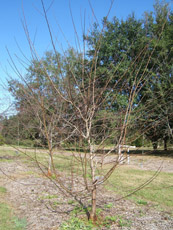Prunus persica 'Florida Home' (Flowering Peach)
*Click on picture for more images of this species.
- USDA Hardiness Zone: 7A? - 9A
- Mature Height: 12 to 20 ft
- Mature Spread: 15 to 20 ft
- Growth Rate: Fast at first, then slow
- Availability: Available
- Drought Tolerance: Moderate
- Salt Tolerance: Unknown
- Light Requirements: Full sun to partial sun.
- Native Origin: Not native to Florida.
- Soil Drainage: Needs a well-drained site.
- Foliage: Deciduous tree with no showy fall color.
- Flowers: Pinkish-red, very showy, in the late winter.
- Pests: Tent caterpillar can defoliate trees and weaken them.
Description: Growing 20 feet tall and wide, Flowering nectarine forms a rounded mass of slender, branches sprouting from a short trunk. In spring, before the one to two-inch-long leaves appear, trees are festooned with small, pink flowers which make the trees quite decorative in the presence of other trees which are often still dormant. The 0.5-inch-diameter fruits which follow ripen to red, and are extremely popular with wildlife and people. The fruit are either eaten fresh or used to make a delicious jelly.
Grown occasionally with a single leader, nectarine is usually seen with a multiple trunk planted as a specimen in a yard under a power line or as an occasional accent. It makes a nice addition to the shrub border in the back yard and is well suited for planting around the patio or deck although it does not form a neat crown and looks a little unkempt during the winter. The crown often leans to one side or the other. Occasional pruning can significantly improve the form of the crown, especially when it is begun when trees are young.
The tree is easily grown and has no special cultural requirements. It tolerates drought poorly and does poorly in alkaline pH. These small trees grow quickly but have a relatively short life. This should not stop you from planting the tree since it will serve the landscape well during its life.
Gainesville Observations: This tree has been fast growing for us and should be suited for planting near power lines. Flowers have been reliable and beautiful in early February. Rapid growth and aggressive branching habit makes pruning to a dominant leader challenging but possible; heading and reducing cuts are needed to craft a strong structure. Low branches droop toward the ground and require pruning for clearance under the canopy. Probably best reserved for occasional planting in a garden-like soil.


